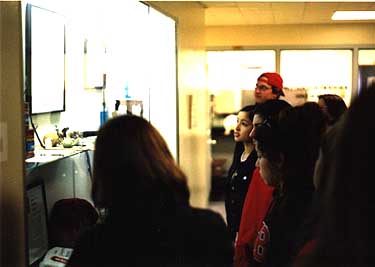|

Local students visiting
the historical society, perusing a vitrine full of
historical victuals. This is before the table we bought for the entrance.
Listen
to voice over artist Tim George

read
the part of Hank Peabody
Visit
Tim George's website to learn more
about his work
www.timgeorgevo.com
The Ikea Story
from The Reeducation of a Turd Peddler
by John Henry Peabody
WHEN
PEOPLE FIRST walk into the historical society, they seem to get
lost. So I had in mind a table that greeted the lost people. It would
be full of handouts and postcards. Free stuff that said, “Welcome!”
Most of it I could produce using the laser printer. Where else might
a person get a free full color pamphlet on Central Coast Native American
coprolites?
You just don’t get that kind of thing at the Olive
Garden.
I looked all over the premises, down in the basement and
out in the lodge attached to the building, hoping that I might run into
my grail, a fold out table in the kind of shape I could use for the
entryway.
But no deal.
After a short discussion, Dolores and I agreed that we needed
to purchase a new one.
“Ikea,” she said, right off. “They’ll
have something that looks good, costs right, is made of wood, and as
long as you don’t turn it upside-down, people will think that it’s
a real quality piece.”
I nodded. “That’s why I hired you, Lo.”
“I’m not actually hired, Hank. It’s a volunteer
position, remember?”
“Right.”
While El Fornio proper would never allow Ikea in its midst,
I could still drive down to Santa Maria where they built a store in
the old tomatillo field just off the 101.
“Alright,” I told her. “I’m hitting
the highway.”
“Can I go with?” she asked.
I looked her over. “Who’s going to watch the ship,
Lo?”
I thought of her riding next to me down the freeway. It
might be sweet.
“I’ll be here,” she said.
“Another time.”
She gently slugged me on the shoulder. “Don’t
get ripped off down there, chump.”
* * *
I got back
to town close to four. Lo helped me move the box from the car into the
building.
I took a screw driver and popped the big staples on the
cardboard. Then I flipped the lid and looked it over.
It must’ve been a minute, maybe longer, that I peered
at the contents. I couldn’t figure out what I was looking at. Was
this the table? Is that what a packaged table looked like?
I stared a bit longer and took it in. My brain said this
was supposed to be a table. There should be at least a large, flat piece
of wood that was the top of the table. But what did it mean, this eight
inch deep box full of wooden support slats, shredded paper stuffing
and 1960s English electronic engineering manuals?
It meant that there was no table.
It meant that it was a scam.
And the scam went so far up the line you wondered how many
boxes like this there were in the world? You wondered who was being
bait-and-switched when and how long ago it was.
I called Dolores into the room. She looked it over.
“How far back does this go?” she asked after about
only four seconds of looking the box over.
“You figured it out right away,” I said.
“Look at the set up, professor. Who ever did this made
sure that not only were the dimensions right, but that each box weighed
the same amount as the table it was supposed to contain. Divide that
now by how ever many fit on—what?” she tossed a hand. “A
palette? A ship? A ship load of palettes?” Lo looked back down
at the box with appreciation. “The people who did this were assholes,”
she lamented. “But they were smart assholes.”
“Russians. What do you think?” I asked. “Only
Russian would do this.”
She looked me over. “I dunno. Ukrainians. Russians.
All I told you was not to get ripped off down there, and you did.”
I shrugged. “Seems like a pretty exquisite rip off
to me.”
|




